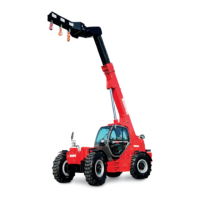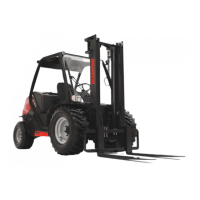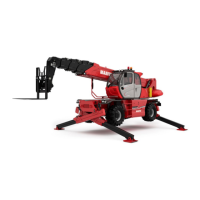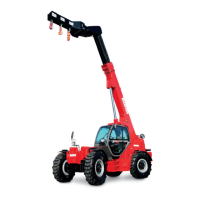1 - 25
2
3
3
1
A1
2
1
A2
A3
2
3
4
1
A4
4
3
2
1
A5
2
1
B1
INSTRUCTIONS FOR USE AS A LOADER
For agricultural-type lift trucks (MLT range)
A-LOADING
t
IMPORTANT
t
In no circumstances should you raise the boom if you have not checked the transverse attitude of the lift truck
(eINSTRUCTIONS FOR HANDLING A LOAD: D-TRANSVERSE ATTITUDE OF THE LIFT TRUCK).
REMINDER: Make sure that the following operations can be performed with good
visibility (e OPERATING INSTRUCTIONS UNLADEN AND LADEN:
D-VISIBILITY).
FILLING THE BUCKET
- Place the bottom of the bucket in a horizontal position, just in contact with the
ground (1) (fig.A1).
- Move forward gradually (2) while simultaneously raising the boom and tilting the
bucket backwards (3), for improved filling and breakout (fig.A1).
- Reverse the lift truck (1) very carefully and gently to free the bucket. Lower the
boom (2) into the transport position (fig.A2).
t
IMPORTANT
t
Tilt the bucket sufficiently back to avoid spilling product and ensure its stability (loss of product under braking).
LOADING A TRAILER
- Approach the side of the trailer in the transport position (fig.A3).
- Raise and extend the boom (1) (2) until the bucket is above the trailer, while
monitoring the longitudinal stability limiter and warning device (
eINSTRUCTIONS
FOR HANDLING A LOAD: C-LONGITUDINAL STABILITY LIMITER AND WARNING
DEVICE) (fig.A4).
- Drive the lift truck forward (3) very carefully and gently so that the bucket empties
its load in the centre of the trailer (fig.A4).
- Apply the parking brake on and set the reversing lever to neutral.
- Slowly discharge the product (4) (fig.A4).
- Tilt the bucket backwards (1) and reverse the lift truck (2) very carefully and gently
(fig.A5).
- Retract (3) and lower the boom (4) into the transport position (fig.A5).
B-BACKFILLING
- Place the bottom of the bucket in a horizontal position, just in contact with the
ground (1) (fig.B1).
- Drive forward gradually (2). Once filled, the bucket will act as a levelling blade (fig.B1).
t
IMPORTANT
t
When driving, beware of trenches as well as recently excavated and/or backfilled ground.

